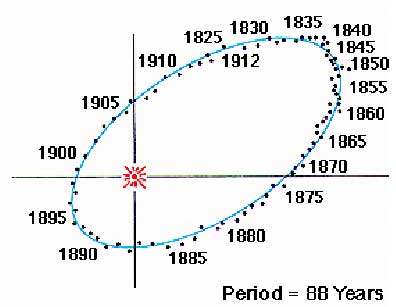Lesson Plans: Time that Star! (Binary star information)

Time That Star!
Binary Stars
About half of the stars visible in the night sky are not single stars at all, but are actually multiple star systems or double stars. The gravitational force between the two stars in a binary system keeps them in orbit about each other.
Our star, the Sun, is not in a binary system, but is considered to be a typical single star. The next nearest star is Alpha Centauri which is 3 x 1013 kilometers away.
For some nearby binary systems, astronomers can make out the two individual stars. When this is true, the binary is called a visual binary (see below). This binary system is Kruger 60 in the constellation Cepheus and has an orbital period of 44.5 years.

Observations of the Kruger 60 binary star system.
In most binary systems, both stars follow an elliptical orbit about their common center of mass.
Below is an illustration of a model of the elliptical pattern of a binary system. Remember, this is just a sample model, it is not the only model.

One model of binary stars orbiting each other in elliptical orbits.
After many years of patient observation, astronomers can plot the orbits of the stars in a visual binary (see below). As you can see, an astronomer has drawn the orbit of one star with respect to the other. This illustration shows the orbit of a faint visual double star in the constellation Ophiucus.

The orbit of a binary star system in Ophiuchus.
X-ray binaries are a special class of binary star systems which emit X-rays. X-ray binaries are made up of a normal star and a collapsed star (a white dwarf, neutron star, or black hole). These pairs of stars produce X-rays if the stars are close enough together that material is pulled off the normal star by the gravity of the dense, collapsed star. The X-rays come from the area around the collapsed star where the material that is falling toward it is heated to very high temperatures (over a million degrees!).

An artist's imparession of an X-ray binary star system. (Credit: NASA/GSFC)

